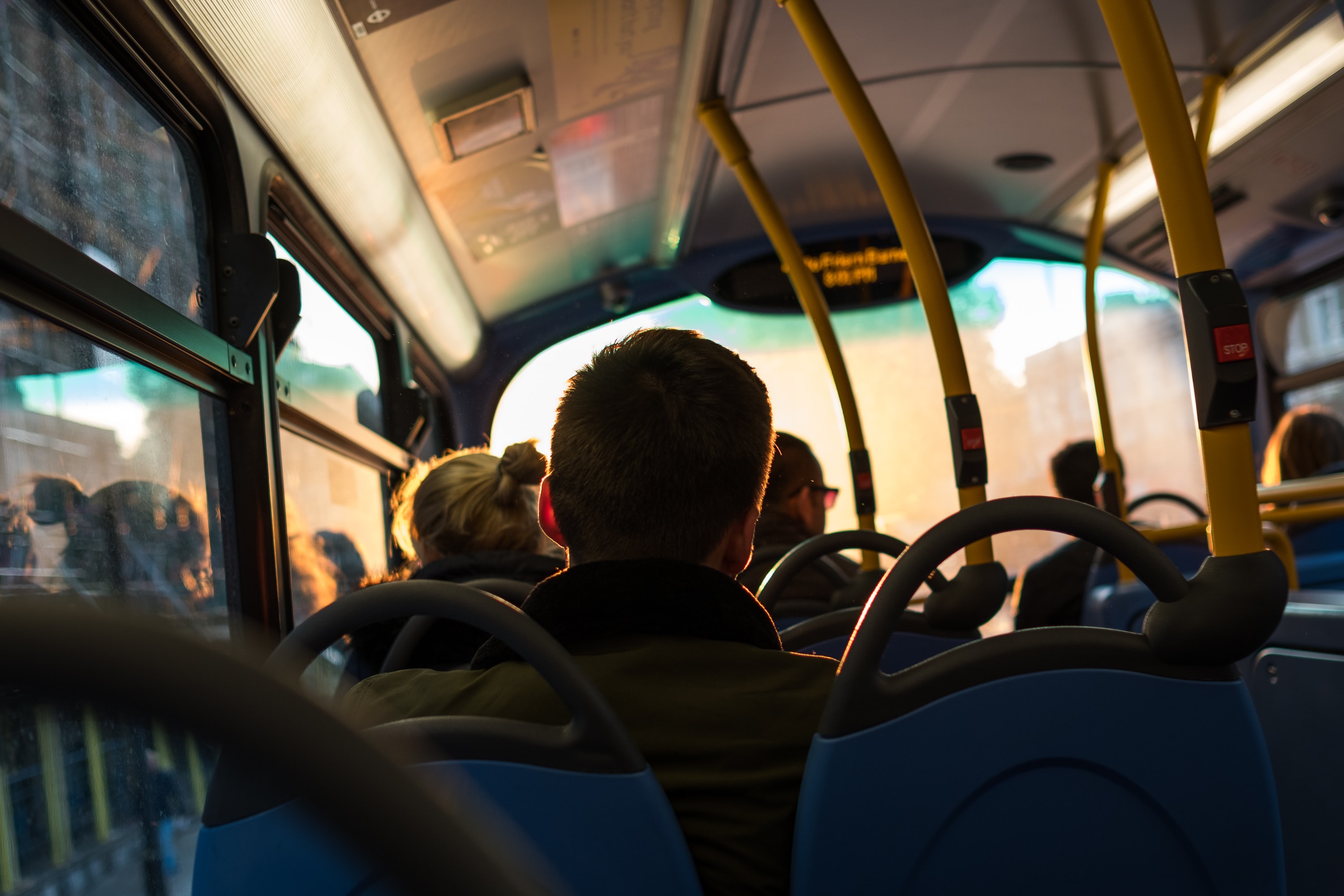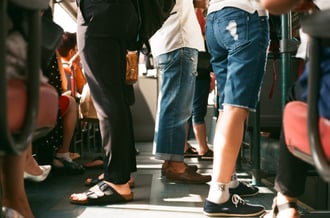7 min read
Sustainable Mobility as a Tool for Climate Action
By: Jenny Fahlbush on Sep 25, 2021 10:55:00 AM

Recently, NOAA ranked July 2021 as “Earth’s hottest month on record.” The news continues a grim trend, with 2016 being Earth’s hottest year, and 2020 in a close second place. According to the California government, 2020 saw the largest wildfire season in the state’s recorded history, with nearly 10,000 fires burning over 4.2 million acres of land across the state. NBC Miami described last year as a “hyperactive hurricane season” producing 30 named storms – 18 more than the average hurricane season. The insurgent number of natural disasters experienced last year undoubtedly points to our changing climate.

Climate change is real, and it’s happening at a faster rate than ever before. According to NASA, increasing temperatures means an increase in sea levels, loss of sea ice, more extreme weather events, and resource scarcity.
The question, now, is how do we as a transit
Industry do our part to lessen the damage for future generations?
The EPA found that the transportation sector – which includes single-occupancy vehicles (SOVs), airplanes, and freight transport – accounts for the largest portion of total U.S. greenhouse gas emissions. And, of that sector, emissions from light-duty vehicles such as cars and pickup trucks make up 59% of the total. The EPA also noted that buses and rail make up a significantly smaller proportion of the sector total. All of this points to increased transit use as the single most impactful activity Americans can due to mitigate climate change. Investing in public transit is therefore a critical component to attracting those passengers and reducing our greenhouse gas emissions.
Public transit has a significantly smaller carbon footprint than SOVs, which positions the industry well to effectively combat the rapidly changing climate. According to APTA, public transit can save the U.S. 4.2 billion gallons of gasoline annually – the same amount of gas it would take for a midsize car to drive from New York to Los Angeles roundtrip over 18 million times. Additionally, communities that invest in public transit reduce the nation’s carbon emissions by 37 million metric tons annually. That’s enough to fill the largest aquarium in the world – which holds over 12.9 million gallons of water – nine times over.
Addressing climate change may be a global challenge, but increased transit use has the local spinoff effect of improving public health by reducing particulates in the atmosphere, lessening the heat island effect, reducing noise pollution, increasing public safety, and lessening traffic – all immense improvements to quality of life in both urban and suburban areas.
Although public transit investment is vital to the health and wellbeing of the environment, it faces significant hurdles. Not only has ridership decreased in recent years, but the pandemic has also placed additional pressure on already lean budgets. As local public transit agencies grapple with these issues, our industry must create more passenger-focused services to increase ridership and move toward decreased emissions.
Keolis has always strived to think like our passengers and to hold their needs and expectations at the highest priority. We care about our agencies and the people their systems serve, and we believe there has never been a more crucial time to empower mobility in our communities. We have three key recommendations on how public transit agencies can work to increase ridership and, in turn, directly influence the creation of cleaner environments by reducing mainstream reliance on SOVs.
1) Improve understanding of how communities move
First, by improving our understanding of how residents get around their communities, policymakers and transit officials can meet people where they are, providing bespoke mobility solutions that cater to the individual needs of the community in question – rather than a one-size-fits-all approach based on outdated information and old preferences. Solving this challenge is critical to us and our partners, and it is why we’ve launched Keolis Evolve: our answer to the collective need for more actionable data to inform how agencies allocate transit resources to bring riders back to public transit. By helping them understand how to meet modern demand, agencies can reduce financial and environmental costs and use those savings to expand to new, transit-hungry markets – a process Keolis is currently doing in Reno, NV; Foothill, CA; and Greensboro, NC.
2) Deliver a better rider experience
 Second, we must continue to ensure the quality-of-service is consistently meeting the expectations of the passenger. This means not only serving our passengers, but thinking like them to do so. Public transit agencies must have a deep and evolving understanding of not just those who are dependent on transit service, but also segments of the population with latent demand. We in the public transit industry need to continuously consider and shape our approach to operating networks so that we deliver a better rider experience. Agencies must consistently ask themselves: In what ways can we better the transportation experience for our passengers? This is exactly what Keolis has helped its partners do in cities like Greensboro, NC, and Las Vegas, NV. By asking the right questions about demand and rider experience, we have developed strategies to better match rider appetite by boosting access to underserved areas, adding service to regional airports, and adjusting routes while decreasing travel time.. By asking the right questions about demand and rider experience, we have developed strategies to better match rider appetite by boosting access to underserved areas, adding service to regional airports, and adjusting routes while decreasing travel time.
Second, we must continue to ensure the quality-of-service is consistently meeting the expectations of the passenger. This means not only serving our passengers, but thinking like them to do so. Public transit agencies must have a deep and evolving understanding of not just those who are dependent on transit service, but also segments of the population with latent demand. We in the public transit industry need to continuously consider and shape our approach to operating networks so that we deliver a better rider experience. Agencies must consistently ask themselves: In what ways can we better the transportation experience for our passengers? This is exactly what Keolis has helped its partners do in cities like Greensboro, NC, and Las Vegas, NV. By asking the right questions about demand and rider experience, we have developed strategies to better match rider appetite by boosting access to underserved areas, adding service to regional airports, and adjusting routes while decreasing travel time.. By asking the right questions about demand and rider experience, we have developed strategies to better match rider appetite by boosting access to underserved areas, adding service to regional airports, and adjusting routes while decreasing travel time.
3)Bridge the access gap for better service in all communities
Finally, we must continue to ensure the best for our communities’ transit networks. This means not only providing exceptional service to passengers, but also ensuring that there is ample access to these systems. For example, we as an industry need to acknowledge the fact that only 10% of U.S. citizens live within walking distance from a public transport service station. This staggering statistic indicates that we should be doing more for the 90% of people that lack easy access to our services; we should focus on bridging those access gaps for all riders. We should also identify and change outdated service routes that no longer serve the public the way that they should. Recognizing and these areas for improvement is the first step. Addressing them will bring us one step closer to delivering unparalleled, modernized modes of transportation to our passengers.
Newer technologies make these expansions of access and user experience easier than ever. Responsible, data-driven, and locally sensitive growth into new markets means more communities can reduce their dependence on SOVs and take another step towards significantly reducing the transit access gap – key pieces in Keolis’ mission to make transit systems more efficient, more sustainable, more inclusive, and more responsive to meet the true mobility needs of our communities.
Related Posts
How a Focus on Equity Can Boost Ridership Post-Pandemic
As COVID-19’s restrictions, lockdowns, and isolation begin to fade in many parts of the U.S. and...
The Role of the Private Sector in Building Back Better Transit
This article was originally published on May 2, 2022 in Metro Magazine.
Five Transit Trends of 2022 – and What’s Ahead in 2023
Transit continued its ridership growth in 2022. Read on to look back on some of the past year’s...